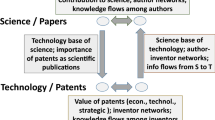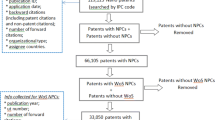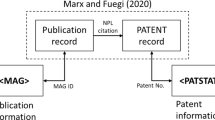Abstract
Nanosciences and nanotechnologies are considered important for the development of science, technology and innovation, and the study of their characters can be a great help to the decisions of policy makers and of practitioners. This work is centred on the issue of the time relations between science and technology/innovation, and in particular on the speed of transfer of science-generated knowledge towards its exploitation in patenting. A methodology based on patent citations is used in order to measure the time lag between cited journal articles and citing patent, and thus the time proximity between the two steps. Keywords regarding nanotechnology/nanoscience items are searched in order to collect data useful for the analysis. Collateral measures, performed on another class of materials and on the spatial origin of citing/cited documents, help giving evidence of the peculiarity of the behaviour and on its nature. The most representative time lag between production of scientific knowledge and its technological exploitation appears being around 3–4 years.



Similar content being viewed by others
Notes
http://www.nano.gov/, accessed July 2010.
See http://www.cas.org/index.html, accessed July 2010.
Canadian Intellectual Property Office (CIPO), European Patent Office (EPO), French Patent Office (INPI—Institut National de la Propriete Industrielle), German Patent Office (DPMA), Japanese Patent Office (JPO), Russian Patent Office (ROSPATENT—Russian Agency for Patents and Trademarks), United Kingdom Intellectual Property Office (UK-IPO), United States Patent & Trademark Office (USPTO), World Intellectual Property Organization (WIPO).
The subscription price for SCI Finder Scholar is of several ten thousand Euros for each single access for 1 year. This means that if two persons need to access SCI Finder Scholar at the same time from two computers in the same institution (e.g. library) the fee is doubled.
References
Avenel, E., Favier, A. V., Ma, S., Mangematin, V., & Rieu, C. (2007). Diversification and hybridization in firm knowledge bases in nanotechnologies. Research Policy, 36(6), 864–870.
Bacchiocchi, E., & Montobbio, F. (2009). Knowledge diffusion from university and public research. A comparison between US, Japan and Europe using patent citations. The Journal of Technology Transfer, 34(2), 169–181.
Balzani, V. (2005). Nanoscience and nanotechnology: A personal view of a chemist. Small, 1(3), 278–283.
Bertinetti, L., Tampieri, A., Landi, E., Ducati, C., Midgley, P. A., Coluccia, S., et al. (2006). Surface structure hydration, and cationic sites of nanohydroxyapatite: UHR-TEM, IR, and microgravimetric studies. Journal of Physical Chemistry C, 111(10), 4027–4035.
Binnig, G., & Rohrer, H. (1986). Scanning tunnelling microscopy. IBM Journal of Research and Development, 30(4), 355–369.
Bonaccorsi, A., & Thoma, G. (2007). Institutional complementarity and inventive performance in nanoscience and technology. Research Policy, 36(6), 813–831.
Bozeman, B., Laredo, P., & Mangematin, V. (2007). Understanding the emergence and deployment of “nano” S&T. Research Policy, 36(6), 807–812.
Breschi, S., & Catalini, C. (2010). Tracing the links between science and technology: An exploratory analysis of scientists’ and inventors’ networks. Research Policy, 39(1), 14–26.
Celotti, G., Tampieri, A., Sprio, S., Landi, E., Bertinetti, L., Martra, G., et al. (2006). Crystallinity in apatites: how can a truly disordered fraction be distinguished from nanosize crystalline domains? Journal of Materials Science-Materials in Medicine, 17(11), 1079–1087.
Coccia, M., Finardi, U., & Margon, D. (2010). Research trends in nanotechnology studies across geo-economic areas. CERIS-CNR working paper series, WP 05/10.
Coccia, M., Finardi, U., & Margon, D. (2011). Current trends in nanotechnology research across worldwide geo-economic players. Journal of Technology Transfer. doi:10.1007/s10961-011-9219-6.
Criscuolo, P., & Verspagen, B. (2008). Does it matter where patent citations come from? Inventor vs examiner citations in European patents. Research Policy, 37(10), 1892–1908.
Dasgupta, P., & David, P. A. (1994). Toward a new economics of science. Research Policy, 23(5), 487–521.
Evangelisti, C., Vitulli, G., Schiavi, S., Vitulli, M., Bertozzi, S., Salvadori, P., et al. (2007). Nanoscale Cu supported catalysts in the partial oxidation of cyclohexane with molecular oxygen. Catalysis Letters, 116(1-2), 57–62.
Glänzel, W., & Meyer, M. (2003). Patents cited in the scientific literature: An exploratory study of “reverse” citation relations. Scientometrics, 58(2), 415–428.
Hu, D., Chen, H., Huang, Z., & Roco, M. C. (2007). Longitudinal study on patent citations to academic research articles in nanotechnology (1976–2004). Journal of Nanoparticle Research, 9(4), 529–542.
Huang, C., Notten, A., & Rasters, N. (2011). Nanoscience and technology publications and patents: a review of social science studies and search strategies. The Journal of Technology Transfer, 36(2), 145–172.
Hulmann, A., & Meyer, M. (2003). Publications and patents in nanotechnology. An overview of previous studies and the state of the art. Scientometrics, 58(3), 507–527.
Ijiima, S. (1991). Helical microtubules of graphitic carbon. Nature, 354(6348), 56–58.
Islam, N., & Miyazaki, K. (2010). An empirical analysis of nanotechnology research domains. Technovation, 30(4), 229–237.
Kroto, H. W., Heath, J. R., O’Brien, S. C., Curl, R. F., & Smalley, R. E. (1985). C60: Buckminsterfullerene. Nature, 318(6042), 162–163.
Leydesdorff, L. (2007). The delineation of nanoscience and nanotechnology in terms of journals and patents: A most recent update. Scientometrics, 76(1), 159–167.
Leydesdorff, L., & Zhou, P. (2007). Nanotechnology as a field of science: Its delineation in terms of journals and patents. Scientometrics, 76(3), 693–713.
Li, X., Chen, H., Huang, Z., & Roco, M. C. (2007a). Patent citation network in nanotechnology (1976–2004). Journal of Nanoparticle Research, 9(3), 337–352.
Li, X., Lin, Y., Chen, H., & Roco, M. C. (2007b). Worldwide nanotechnology development: A comparative study of USPTO, EPO, and JPO patents (1976–2004). Journal of Nanoparticle Research, 9(6), 977–1002.
Meyer, M. (2000). Does science push technology? Patents citing scientific literature. Research Policy, 29(3), 409–434.
Meyer, M. (2001). Patent citation analysis in a novel field of technology: An exploration of nano-science and nano-technology. Scientometrics, 51(1), 163–183.
Meyer, M. (2006). Measuring science-technology interaction in the knowledge-driven economy: The case of a small economy. Scientometrics, 66(2), 425–439.
Porter, A. L., Youtie, J., Shapira, P., & Schoeneck, D. J. (2008). Refining search terms for nanotechnology. Journal of Nanoparticle Research, 10(5), 715–728.
Schmoch, U. (1993). Tracing the knowledge transfer from science to technology as reflected in patent indicators. Scientometrics, 26(1), 193–211.
Schultz, L. I., & Joutz, F. L. (2010). Methods for identifying emerging general purpose technologies: A case study of nanotechnologies. Scientometrics, 85(1), 155–170.
Zecchina, A., Groppo, E., & Bordiga, S. (2007). Selective catalysis and nanoscience: An inseparable pair. Chemistry–A European Journal, 13(9), 2440–2460.
Acknowledgments
The author acknowledges: Prof. S. Coluccia (University of Torino, Italy) for helpful comments and suggestions, as well as for continuous support; Prof. L. Battezzati (University of Torino, Italy) for present support; Prof. S. Rolfo, Dr. M. Coccia and Dr. G. Vitali (CERIS-CNR, Moncalieri, Italy) for scientific collaboration. The contribution of Prof. F. Malerba (CESPRI-KITES – Università Bocconi, Milano, Italy) for seminal ideas and revision of preliminary material is acknowledged. A preliminary version of this paper is published on the CERIS-CNR Working paper series: the editor and the anonymous referees who reviewed this version are also acknowledged. Directors of libraries “G. Ponzio” (Chemistry) and “I. Guareschi” (Pharmacy) of University of Torino are acknowledged for allowing extensive use of SCI Finder Scholar. Usual disclaimer applies.
Author information
Authors and Affiliations
Corresponding author
Rights and permissions
About this article
Cite this article
Finardi, U. Time relations between scientific production and patenting of knowledge: the case of nanotechnologies. Scientometrics 89, 37–50 (2011). https://doi.org/10.1007/s11192-011-0443-5
Received:
Published:
Issue Date:
DOI: https://doi.org/10.1007/s11192-011-0443-5
Keywords
- Patent-research relations
- Patent
- Journal article
- Nanosciences
- Nanotechnologies
- Technological trajectories
- Data mining
- Innovation
- Knowledge diffusion




